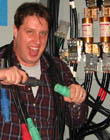|
|
 
|
|
Author
|
Topic: "double Jepardy"
|
|
|
|
|
|
|
|
|
|
|
Bill Carter
Expert Film Handler

Posts: 162
From: Minneapolis, Minnesota
Registered: Sep 1999
|
 posted 09-30-1999 10:48 AM
posted 09-30-1999 10:48 AM




There's been a very steady decline in the general quality of release printing over the past several years. Labs are so concerned with cutting costs now, they generally don't replentish processing chemistry until it is totally depleted. In other words, until it doesn't have enough strength to resolve an image on the film any more. Even if there's only enough left to process two or three hundred feet, they won't waste it.They'll let the roll keep going until there's no longer an "acceptable" image, then make a splice and pick it up there after replentishing the chemicals. The result is either a "white out", or a shift to some ugly color, depending on which chemical step was exhausted. Years ago, most labs would reprint a reel free on request if they made 2 or more splices in it. Now, there's no such deal. It's fairly tough to get most labs to fix any of their mistakes without paying for a reprint. They certainly aren't going to call your attention to their mistakes, and the distributors aren't going to individually inspect 2000 new release prints when they're rushing to meet a release date.
| IP: Logged
|
|
John Pytlak
Film God

Posts: 9987
From: Rochester, NY 14650-1922
Registered: Jan 2000
|
 posted 10-01-1999 01:15 PM
posted 10-01-1999 01:15 PM





The image going clear in the middle of a reel usually would be due to a brief failure of the printer lamp (or power supply), or a miscue causing the fader to close. In most cases like this, the soundtracks would continue, as they are printed by separate heads on the printer. Normally these obvious problems are caught, as the processing machines usually have a projection system to inspect the image as the film winds up. A certain percentage of prints are also inspected on high speed projectors or inspection machines. Lab splices are an unfortunate, but necessary, economic reality for the labs. The raw stock is usually supplied as 4000-foot or 6000-foot lengths, and most reels are not exact increments of these lengths. If a lab was printing three 1800-foot reels on a 6000-foot roll of raw stock, they would waste a 600-foot "short end" worth about $50.00 if they didn't use lab splices. Most labs are very good in maintaining control of the processing chemistry and sensitometry. The Association of Cinema and Video Laboratories (ACVL) publishes a "Handbook of Recommended Procedures for Motion Picture and Video Laboratory Services" for its members, including such items as laboratory splices. It says: "There should never be two raw stock splices in the same reel. It is further recommended that spliced raw stock not be used for trial prints, dailies, TV spots, or recording prints. It is customary practice to charge a premium for release prints that have no raw stock splices".
| IP: Logged
|
|
|
|
All times are Central (GMT -6:00)
|
|
Powered by Infopop Corporation
UBB.classicTM
6.3.1.2
The Film-Tech Forums are designed for various members related to the cinema industry to express their opinions, viewpoints and testimonials on various products, services and events based upon speculation, personal knowledge and factual information through use, therefore all views represented here allow no liability upon the publishers of this web site and the owners of said views assume no liability for any ill will resulting from these postings. The posts made here are for educational as well as entertainment purposes and as such anyone viewing this portion of the website must accept these views as statements of the author of that opinion
and agrees to release the authors from any and all liability.
|

 Home
Home
 Products
Products
 Store
Store
 Forum
Forum
 Warehouse
Warehouse
 Contact Us
Contact Us




 Printer-friendly view of this topic
Printer-friendly view of this topic














